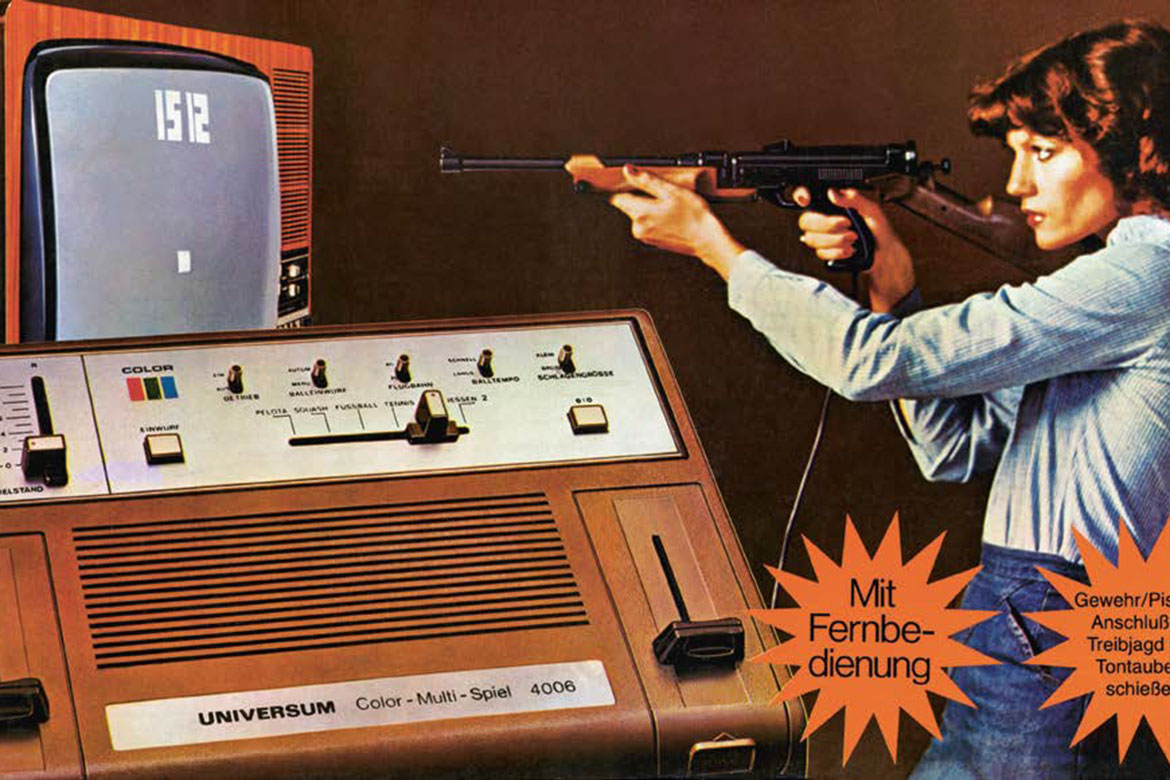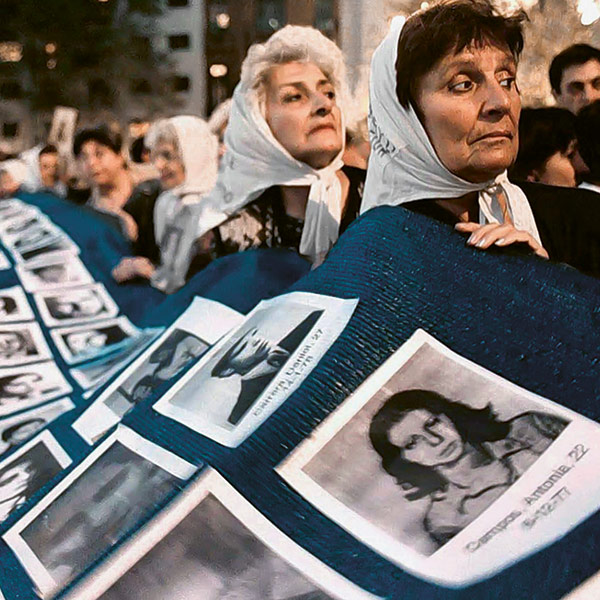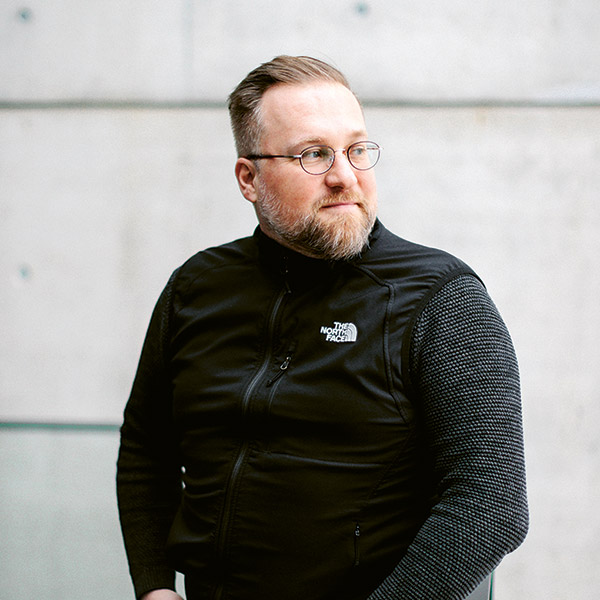The appeal of arms
In order to keep peace in society, the state controls the ownership of weapons. But that wasn’t always the case.

An early video game console, Universum Color-Multi-Spiel 4006, Germany, ca 1976. Besides shooting games there was a choice of video games such as squash and pelota. | Photo: Keystone/Interfoto/TV-Yesterday
If a man keeps a pistol on his office desk, he's going to have to do some serious explaining to his work colleagues, regardless of whether he bought it legally, and even if it isn't actually loaded. If young men proudly show their illegally acquired butterfly knives to their friends, they hide them under their bomber jackets afterwards. And if children play with toy guns and point them at other kids, we warn them not to do it again.
Weapons are a taboo in civil society. However, this taboo bears a hidden dialectic within it: what's dangerous is admired; what you can't touch seems to possess magical powers. A weapon can kill another human being in the blink of an eye. On the one hand, they are only supposed to be borne in public by state representatives such as the police and soldiers. On the other hand, they are in constant use in society's great space of the imagination: the cinema, where people on screen take great pleasure in shooting and murdering each other. Even pacifists watch thrillers. And weapons are indeed among us: as the Swiss newspaper Tages-Anzeiger reported in December 2015, some two and a half million legal weapons are circulating in Switzerland, almost hidden from sight. Half of these are army weapons.
Arms and the aristocrats
Until the peace movement and pacifism emerged in around 1900, weapons had an exclusively positive connotation and were proudly carried in full view. Weapons today are often barely seen and have a purely functional design, but for centuries they were richly ornamented and were a signifier of high social status. Carrying 'cut-and-thrust' weapons was the preserve of the nobility in the Middle Ages and Early Modern times. They were the group that led the way in everything, and they delighted in parading around on their steeds. Their privilege to bear arms ensured that they had the power. If a serf in bondage fancied rising up, his threshing rod wouldn't have had a chance against the long spears and swords of his masters high on their horses.
In the Middle Ages, aristocratic clans indulged in bloody vendettas that were a burden on both the land and the people. Without bothering about laws or courts, knights laid waste to the farms where their enemies' serfs lived. This brought misery to the peasants, and also made it difficult to secure emerging transport routes. This in turn vexed those citizens who were involved in trade. In everyday life in the villages and cities, however, people kept a knife handy about their person. If someone uttered the wrong words or made a gesture that was taken as an insult, knives might be drawn quickly. The mediaevalist Arnold Esch gathered together numerous proofs of such behaviour in his book 'True stories from the Middle Ages' (2010).
Phallic swords
The citizens' councils in the emergent cities of the late Middle Ages curbed this kind of violence, says the Bernese historian André Holenstein: "They instituted peace regulations. Not just stabbings were punished – even just drawing a knife and the symbolic threat of violence were made punishable". Also liable to prosecution were those who did not urge two squabbling parties to keep the peace, but simply got out of the way instead. One common punishment comprised breaking the knife or dagger of the offender, says Holenstein: "By destroying the weapon, the authorities took away the offender's manly honour".
One doesn't have to have read Sigmund Freud to see this as a symbolic act of castration. The weapon as phallus had an undisputed symbolic value in the Middle Ages and Early Modern era, one that ennobled its bearer with masculinity. When fitted out with a sword, a man was regarded as powerful, potent and honourable.
One doesn't have to have read Sigmund Freud to see this as a symbolic act of castration. The weapon as phallus had an undisputed symbolic value in the Middle Ages and Early Modern era, one that ennobled its bearer with masculinity. When fitted out with a sword, a man was regarded as powerful, potent and honourable.
The relicts of the old military traditions of the Swiss Confederacy survive with both the Appenzell Cantonal Assembly – where citizens have to turn up wearing their swords – and the notorious assault rifle of the Swiss militia army – kept at home in the proverbial broom cupboard. A man who isn't armed isn't a real man. 'Women's weapons', however, are traditionally regarded as referring solely to their physical charms. Women do carry 'real' weapons, but the most popular among them is the pepper spray, which is not covered by the Swiss Federal Law on Weapons, Weapon Accessories and Munition (unlike in Belgium and the Netherlands, which do proscribe it). And there are not many men who would carry a pepper spray with them. But a women who shoots a gun is still considered a cause for bemusement, at least in Switzerland.
Well-armed Swiss mercenaries
In the Early Modern era, the Swiss Confederacy was the only country in Europe in which farmers and normal citizens were allowed to bear arms. In fact, they were compelled to do so, because military service was regarded as the prime duty of a citizen. The Swiss affinity for weapons resulted in such famous equipment as the 'Swiss degen' sword, the 'Prättigauerknüttel' and the 'Luzernertrüssel' (both are kinds of mace), as is amply documented in the Swiss Historical Dictionary. The European monarchies did not trust their own subjects in times of war, but resorted to mercenaries instead – preferably young Swiss men. And shrewd Swiss businessmen made a lot of money from them. These mercenaries were better armed than the Swiss militias, which towards the end of the Ancien Régime were in a truly pitiful state.
Indeed, the first nation to set up an effective people's army – and thus the first to overcome the fear of arming its own citizens – was actually the young revolutionary, republican regime in France. In 1792, the new French democracy mobilised about a million soldiers. They went to battle first to protect their republic, and then to expand it. 'Aux armes, citoyens!' runs the Marseillaise – 'arm yourselves, citizens!'
Thus the state democratised weapons, but at the same time it increased its control of them, thereby making a peaceful society possible. The state determines who is allowed to own a weapon and how he or she may use it. Duelling is forbidden. This remnant of mediaeval feuds was still practised in Germany in the early 20th century. In a duel, the offended party sought to restore his honour by force of arms and without recourse to the state judiciary. But this was an affront to the state's monopoly on the use of force. Today, civilians are allowed to shoot in sports clubs only.
A pacified society
When measured by the number of violent crimes committed, today's society is a peaceful one. In the West, the murder rate has never been as low as it is today. In his book 'On the process of civilisation' of 1939, the sociologist Norbert Elias links this pacification process to the increasing control that humans exercise over their emotions. He finds it was reflected in the sophistication of table manners and in the usurpation of the life-threatening dagger by the dining fork. If someone feels offended by another person, he doesn't just start punching him. And if he does it anyway, then he himself becomes punishable by law.
All the same, weapons are still used repeatedly to commit all kinds of crimes including murder. You can in theory kill someone with a bread knife, but a machine gun is more efficient at it. And a bomb is even more efficient still. In the wake of the terror attacks in Paris in 2015 and in Brussels in 2016, the European Union is planning to tighten up its weapons laws. Similar measures are always demanded in Switzerland whenever a man runs amok with his army gun. The debate about regulation versus self-protection is all about whether or not the state should intensify its weapons controls. It's an age-old story, and it's impossible to know where it's going to end.
Urs Hafner is a science journalist in Bern.




